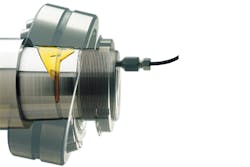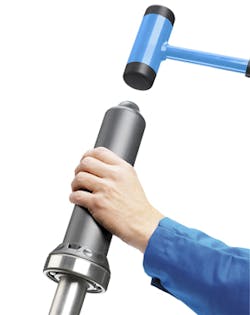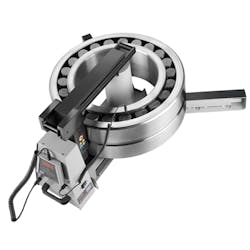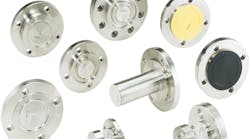In theory, the life of a rolling bearing can exceed the life of the machinery in which it performs. In real-world experience, however, bearing failures occur for a variety of reasons. One critical reason bearings fall short of their pre-calculated service life is improper mounting.
When a bearing is mounted improperly — without utilizing the correct techniques and tools — the bearing’s service life will be jeopardized. The numbers tell the story. An estimated 16 percent of all premature bearing failures can be directly attributed to poor fitting (usually due to brute force installation) and the absence (or lack of knowledge) of the correct fitting tools. Using best practices for mounting a bearing can help avoid future problems and ultimately extend bearing performance and longevity in service. Along the way, both the efficiency and productivity of an operation can advance with an associated increase in machinery uptime.
Taking care from start to finish
Rolling bearings play vital roles in rotating machinery by helping to reduce friction, transmit loads, and locate and support shafts. Thousands of bearing types and styles offer a wide range of solutions suitable for fluid movement applications. At the beginning of the application, success or failure originates with the mounting process.
The challenges: An excessively loose fit for a bearing will allow relative movement between mating components, resulting in fretting, smearing, scoring, wear, excessive heat, and/or fracture. Conversely, an extra-tight fit will reduce the bearing’s internal clearance, which in most cases will increase the operating temperature of the bearing in service. Additionally, an increase in mounting forces is also required, which can potentially fracture a bearing’s ring. These challenges underscore the need both for knowledge and care from start to finish when mounting bearings.
READ ALSO: A Better Way—Empowering operators to play a more direct role in predictive maintenance
Proper mounting of ball and roller bearings begins with care in their storage and handling. All bearings should be stored in a cool, clean, low-humidity environment free of dust, shocks and vibrations. For these reasons, storing bearings directly on a floor should be avoided. Bearings should ideally be stored flat rather than on end. They also should be kept in their original, unopened packages until just before mounting. If kept in a standing position, the likelihood of false brinelling (marking of the raceways and rolling elements caused by residual vibration) increases significantly. False brinelling is much less likely to occur in bearings that are lying flat.
Operators should be cautious when storing sealed or shielded types of bearings over long periods of time. The lubricating properties of the grease used to fill these types of bearings may deteriorate, causing potential lubricant-related problems when a system is up and running. Most bearing manufacturers have specific shelf-life limits, based upon the greases used in their bearings.
The importance of cleanliness cannot be over-emphasized. All rolling bearings should be kept clean, because contamination and corrosion will shorten the life of any bearing.
Before a bearing is ready to be mounted, operators should confirm:
- Housing and shaft are clean, undamaged, and dimensionally accurate
- Lubricant is clean and correctly specified
- Necessary tools and equipment are on hand
- Proper safety precautions are in place
Running from cold to hot
The primary methods for proper mounting of a bearing are commonly referenced as "cold" or "hot," consistent with their enabling technologies. Cold mounting, or mechanical mounting, generally is recommended for small- and medium-sized bearings (with outside diameters up to 4"); methods involving heat mounting will be appropriate for relatively larger bearings; and hydraulic techniques should be considered when mounting especially large bearings. Tools have been developed to accommodate each particular method.
In cold mounting, the misguided practice of using a standard hammer and pipe for the job has long been discredited due to the damage that can occur. This practice can cause debris to enter the bearing or, if not done properly, a pipe can slip and impact the internals of the bearing. The best practice is to use fitting tools to eliminate the possibility of damage from harmful brute force. Fitting tools ensure the proper force is applied to both bearing rings and isolates the rolling elements from impact force, thus providing a more reliable installation and limiting the risk of damage.
Hot mounting, where the bearing is pre-heated, provides a practical solution to allow for a bearing’s expansion and subsequently easier installation, while maintaining specified interference fit after the job is completed. How the heat is supplied, however, can make all the difference in the world.
For example, conventional hot oil baths raise the probability of contamination (and premature bearing failure) and flashing. Other techniques (such as exposure to an open flame) fall short, too, and can be potentially dangerous. The best practice is induction heating, which involves heating bearings prior to installation to allow for a high degree of control, efficiency and safety.
Induction heaters can integrate various features to help prevent bearing damage during the heating process. These solutions stand in direct contrast to less effective (and potentially dangerous) methods, including an open flame, hot oil baths, and ovens or hot plates.
For large-sized bearings, hydraulic techniques and compatible tools and equipment are recommended. Hydraulic techniques allow for more control and further help to maintain precision, accuracy, and repeatability; minimize the risk of damage to bearings and shafts; require less manual effort; and promote greater operator safety.
Enabling technologies & tools
A basic understanding of the methods and some of the technologies and tools to effectively mount bearings can advance the cause, both for operators and for operations. The following is a brief review of methods and how they can be practiced successfully.
Mechanical mounting: This method applies force to a bearing by placing a fitting tool, impact ring, and sleeve against the bearing’s ring with the interference fit and using a press or similar acting device to advance the bearing evenly to its proper location on a shaft. The correct combination of impact ring and sleeve will effectively transmit mounting force to a bearing’s ring, minimizing the risk of damaging the bearing’s raceways or rolling elements. As a best practice before proceeding, the bearing should be positioned at right angles to the shaft, and the shaft should be lightly lubricated with a thin oil film.
It should be noted that bearing size matters in terms of the required mounting force and whether a mechanical method will be an option. Larger bearings require more force and, because of the need for greater force, larger bearings cannot easily be pressed onto a shaft or into a housing by means of mechanical mounting without damaging either the bearing or its mating surfaces.
Among the more convenient solutions for mechanical mounting, fitting tool kits have been packaged and equipped with a series of impact rings, impact sleeves, and a dead-blow hammer to handle the task (Figure 1). The different sizes of impact rings in such kits provide the versatility to facilitate the mounting of hundreds of different bearings correctly on a shaft and housing (even in blind applications). Impact rings are marked for clear visual identification of the ring’s size and for easy selection. The diameter of an impact ring is designed to precisely fit against both the inner and outer ring side faces simultaneously to avoid damaging the raceways and take some of the guesswork out of the process.
A small diameter of the impact area on top of the impact sleeve effectively transmits and distributes proper mounting force, while a "click" connection between the impact ring and sleeve imparts stability and durability. The nylon double-side head of the supplied dead-blow hammer helps to prevent damaging any components.
Heat mounting: The temperature difference between a bearing and seating during a heat mounting process will depend on the magnitude of the interference fit and the bearing size. Normally, a bearing temperature of 150 F (83 C) above that of the shaft is sufficient. Unless otherwise specified, open bearings should never be heated to a temperature greater than 257 F (125 C). Extreme heat can cause the bearing’s metallurgy to change, which can alter bearing dimensions and/or hardness. Sealed/shielded bearings will have lower prescribed heating limits, because of the lower limits associated with the lubricant in the bearings, as well as the seal material.
Experience has demonstrated that among the methods for mounting a bearing using heat, induction heaters offer the best performance.
By comparison, localized overheating of a bearing should always be avoided and, in particular, a bearing should never be heated using an open flame, such as a torch. This can risk shaft and bearing damage, result in lack of uniform heating and temperature control, and present fire and health hazards.
An alternative method—hot oil baths—sometimes will be used to heat bearings, but this method, too, fails to attain the level of best practice. Oil baths often will take a long time to reach the required temperature and present challenges in controlling the actual temperature of the bearing. In addition, the energy consumption of an oil bath typically will be significantly greater than using an induction heater. The risk of contaminating the bearing (due to dirty oil) is high (leading to potentially premature bearing failure) and handling hot, oily, and slippery bearings presents unnecessary hazards to an operator, requiring an extremely high level of care to avoid potential injuries. Disposal of the oil following the process presents environmental issues.
While ovens and hot plates can be used relatively acceptably for batch heating of small bearings, their use for heating larger bearings generally will be inefficient and time-consuming, as well as adding to potential handling hazards for operators.
As a result, induction heaters, including portable versions, offer one of the more advanced and all-inclusive technologies in line with best practices. These solutions have been equipped with design features promoting consistent performance, ease of use, and safety. Further, in operation, induction heaters generally will be faster, cleaner, more controllable, and easier to use.
Among noteworthy features, foldable bearing support arms can allow larger-diameter bearings to be heated and reduce the risk of a bearing toppling during heating; ergonomically designed yokes help reduce operator fatigue; unique remote control (with operating display and control panel) enables operators to control the heater at a safe distance from a hot bearing; and an integrated induction coil located outside a heater’s housing reduces heating time to promote lower energy consumption (Figure 2).
One note of caution: Induction heaters produce an electric current, which magnetizes the bearing. Operators should subsequently demagnetize the bearing to prevent the attraction of metal particles and potential contamination leading to premature failure. (Some manufacturers’ induction heaters will automatically demagnetize the bearing at the end of the heating cycle.)
Hydraulic Mounting: This method for mounting very large bearings with interference fits delivers a big assist. The best practice for hydraulic mounting techniques typically involves a combination of oil injection; the use of a specialized hydraulic nut to develop the required hydraulic pressure for effective mounting; and a hydraulic pump with pressure gauge (Figure 3).
Shafts prepared (during manufacture) with oil ducts and grooves can accept oil injected between the bearing bore and shaft surfaces, which creates a thin oil film, reducing both the friction and the required force to mount a bearing. With oil film applied, bearings then can be physically mounted by pushing them up the shaft with the assistance of a hydraulic nut and pump (whose pressure can be monitored by means of the gauge).
A variety of oil injectors, hydraulic nuts and pumps—with some tailored to specific bearing types—have been shown to ease the process of installing especially large bearings.
Taking into account all the methods and best practices covered in this article, as well as enabling technologies and tools, a primary objective in mounting a bearing is to apply minimum required force with maximum control. How bearings are installed will influence their performance, reliability, efficiency, service life, and the operation of system machinery.
Daniel Juchniewicz is an applications engineer for SKF USA Inc., who has been with the company for four years. He graduated from Lehigh University in Bethlehem, Pa. with a bachelor of science in mechanical engineering. Juchniewicz can be reached at [email protected] or 267-436-6647.




